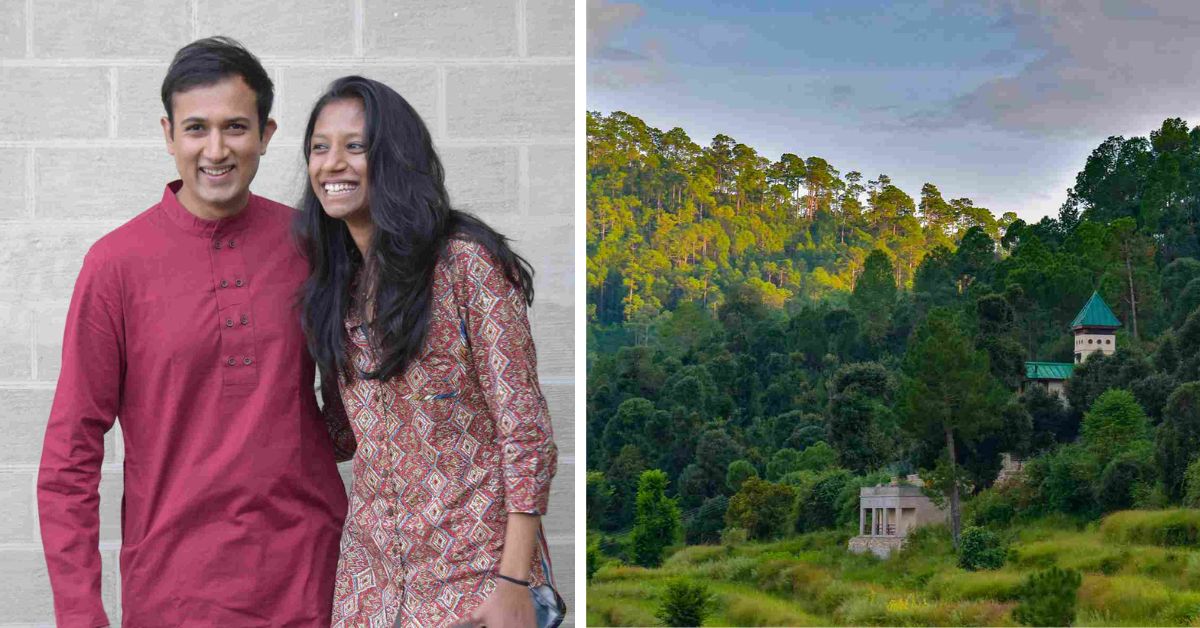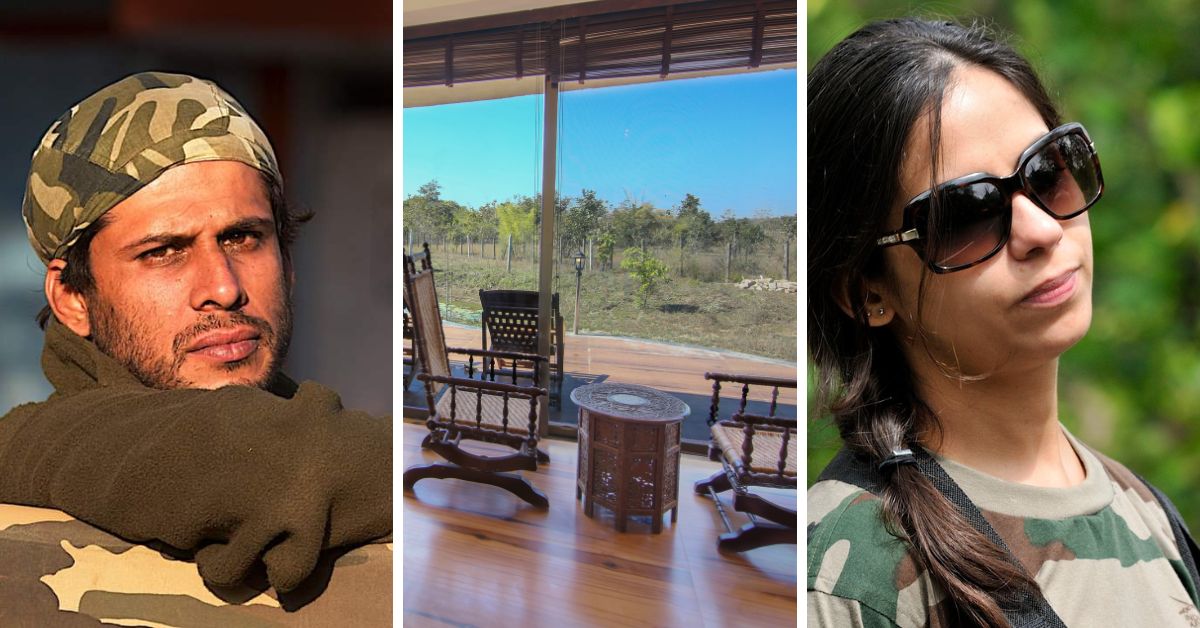7 Techies Who Engineered Success in Sustainable Tourism With Their Dreamy Homestays
When it came to choosing between the corner office and one in the midst of trees, these techies chose the latter. The gorgeous sustainable homestays they have created are a testament to their passion.

Years ago, seven individuals set out to pursue engineering and other tech-related fields. But mid-journey, they had a calling — a strong urge to adopt a sustainable lifestyle and build a home in nature, where they would welcome guests.
These individuals are strangers to each other but bound by a deep love for the outdoors. Though having unique journeys, today, each of them is at the helm of a booming sustainable tourism venture.
In this piece, we explore the different ways in which they engineered success.
1. Dushyant Vashisht, Bir Terraces

The COVID pandemic-induced lockdown got Delhi engineer Dushyant Vashisht rethinking his life’s path. While Vashisht had set his sights on a master’s degree abroad, a trip to his Uttarakhand ancestral home was a turning point. The next few months saw Dushyant converting the cottage into Bir Terraces — a luxurious homestay tucked away in a seven-acre estate in Kumaon.
Built using the random rubble masonry technique, the homestay imbues sustainability at its core. “Even the inner furnishings have been made from upcycled wood. When we demolished our old family haveli (a manor house) in 2015 to construct the cottage, we upcycled all the wood, which now serves as decor. For instance, the dining table was once a door,” adds Dushyant.
The organic farm on the land has rosemary, thyme, lemongrass, sage, celery, peppermint, parsley, peaches, apricots, plums, and seasonal produce like strawberries, cherry tomatoes, radishes, broccoli, grapes, etc
Book your stay here.
2. Insha Qazi, The Cheese Cottage

If we were to describe a vacation at this Kashmir homestay, we’d summarise it by terming it a dream stay — complete with bonfires at night, walks in fruit orchards, and dinners filled with hot yakhni kofta (a yoghurt-based gravy featuring mutton and spices).
The Cheese Cottage is engineer Insha Qazi’s brainchild, engineered into reality when she returned to Kashmir in 2015 following her marketing studies in the UK.
Speaking of how she decided upon the name, Qazi says, “Tangmarg has a rich tradition of dairy, and my first thought was to set up a cheese factory and utilise the local resources and skills. With its pine-scented air, sunrises, and scenic beauty, Tangmarg would be a great place for tourists.”
The homestay is constructed using local materials like deodar wood and walnut wood, and the decor features jewel-toned upholstery. “We sourced a local wicker man to design wicker plant holders, bathroom baskets, etc. We also used handcrafted Kashmiri carving copperware known as traam,” says Qazi.
Vintage memorabilia dot the homestay’s interiors in the form of antique clocks, provincial French chairs, exquisite chandeliers, dramatic lighting, gilded mirrors, and paintings.
Book your stay here.
3. Athul Bos, Jungle Hut

The Thrissur-based mechanical engineering graduate recalls how his college days were filled with rides across South India on his beloved Pulsar 220. In 2013, Athul began organising all-India trips for those interested, and soon, Himachal Pradesh was where he found himself driving to every other weekend.
When he stumbled upon a 20-year-old cottage in ruins made completely out of stone, mud and wood, he decided to rebuild it into a homestay. “Upon the advice of the villagers, we used a unique mix of soil and cow dung with rock stones and recycled wood to beautify the cottage. It took us two months to complete the renovation works,” says Athul.
Today, Jungle Hut not only welcomes guests but also provides car camping — a concept where food and stay are arranged in a car while travelling.
Book your stay here.
4. Srivathsa Govindaraju, Nature Inspires — Chiguru Ecospace
Growing up in a village in Bengaluru meant techie Srivathsa befriended nature at a young age. So, even as he pursued his studies in software engineering, his mind was constantly oscillating between the corporate world and the outdoors.
It is a no-brainer which he chose. “The time I spent in my village had a very deep impact on me and the choices I made in life thereafter. I was sure of wanting to grow my own food for my immediate family. Eventually, that desire grew bigger and I wanted to involve as many people as possible in farming activities,” he adds.
In 2012, Govindaraju quit the corporate sector and transitioned to being a full-time farmer. His passion project ‘Nature Inspires — Chiguru Ecospace’ at Singadasanahalli village near Magadi, has over 350 species of plants and trees and is a great spot for children to vacation. While at the farm stay, Govindaraju encourages the kids to engage in activities like soap making, bio-enzyme making, rafting and even nature walks.
Book your stay here.
5. Hans Dalal, The Spotted Owlet Homestay

The guest list at The Spotted Owlet Farm House includes city folk from across India as well as the local wildlife — hare, mongoose, snakes, scorpions, lizards, over 60 bird species, over 20 butterfly species, tigers, leopards, wild boar and deer, to name a few. Located near the Tadoba-Andhari Tiger Reserve the homestay is the dream of duo Avantika Chandra and Hans Dalal, the latter a sound engineer turned conservationist.
The homestay boasts three private cottages — Ranthambore, Tadoba and Bandhavgarh — whose decor and artwork are an ode to the geography of these respective national parks. The cottages are sustainable and constructed using locally sourced and recycled materials — stones, gravel, bamboo, and old Mangalore tiles.
The land around the stay is nourished with natural fertilisers and vermicompost, the perfect recipe for a flourishing forest. The proof is in the 700 trees spanning 50 varieties — teak, palash, tendu, mahua, babul, ber, mango, guava, drumstick, coconut, and papaya.
Book your stay here.
6. Hemanshu Joshi, Forest Side Farm
The locals of Kotabagh, a quaint village in Uttarakhand find themselves pointing many folk in the direction of Forest Side Farm — a secluded homestay that is a 40-minute drive from Jim Corbett National Park. The homestay is helmed by Joshi who spent 14 years in Dubai and Muscat working as a Project Manager for an IT and telecom company, before realising that nature is what he craved the most.
An avid farming enthusiast, Joshi has cultivated a sustainable agricultural model on the field with over 300 fruit and medicinal trees.
The temperamental weather plays the perfect host. Choose to walk around the farm stay and revel in the green beauty or have a picnic at the banks of the Guruni River.
Book your stay here.
7. Ashish Godara, Slowness Himalayas

A complete ecosystem. This is what Kriti Bisht and Ashish Godara have managed to create at their Uttarakhand homestay inspired by traditional Kumaoni architecture. Dry stacked stone, mud and lime have gone into the construction with solar energy adding to the tune of sustainability.
At the homestay, the chirp of birds is all the music you will hear and the breathtaking landscapes are all the screen time you will need.
Godara, an engineer and Bisht, a Commerce student created this space in 2019 when they decided to leave Delhi and move to the mountains. The homestay prides itself on permaculture, farmland that grows both local and seasonal vegetables, and delectable vegetarian meals.
Book your stay here.
Edited by Pranita Bhat
If you found our stories insightful, informative, or even just enjoyable, we invite you to consider making a voluntary payment to support the work we do at The Better India. Your contribution helps us continue producing quality content that educates, inspires, and drives positive change.
Choose one of the payment options below for your contribution-
By paying for the stories you value, you directly contribute to sustaining our efforts focused on making a difference in the world. Together, let's ensure that impactful stories continue to be told and shared, enriching lives and communities alike.
Thank you for your support. Here are some frequently asked questions you might find helpful to know why you are contributing?












